Adoptees seek answers from Catholic-run program that sent children of unwed moms to America
Bill Whitaker, Aliza Chasan 10/13/2024In the 1950s American Catholics were eager to adopt thousands of Italian children from an impoverished country. They thought they were saving orphans.
They were wrong.
Most of the children were not orphans. They were the children of unwed mothers who had been pressured into giving up their child by their families and a powerful church. Today, thousands of American adoptees are still struggling to piece together their lost lives, decades after the Vatican's orphan program ended in 1970.
Adoptee John Campitelli felt his entire life was based on a lie once he learned what had happened to him and his birth mother, Francesca. Campitelli is still angry at the church.
"They told her that they would take care of me and that was a lie. They didn't take care of me," he said. "They cut all relationships that I could possibly have with my birth family and they shipped me overseas."
The Vatican's post-WWII orphan program
At the end of World War II, Italy was a shattered country. Hundreds of thousands of children were abandoned in institutions run by the Catholic Church. Alarmed by the growing number of children, the Vatican decided to send children to America for adoption and the promise of a better life.
Between 1950 and 1970, the Church sent thousands of children born out of wedlock to America on orphan visas. The Church arranged the visas, helped by a 1950 U.S. law that broadened the definition of orphan to include a child with one living parent, but a parent who couldn't provide care.
New York author Maria Laurino uncovered the Vatican's orphan program in her new book, out Oct. 15, "The Price of Children." Laurino pieced the story together from hundreds of documents in the Church's New York archives. Laurino told 60 Minutes the linchpin of the program was a consent form that birth mothers were supposed to sign that severed all rights to the child. But Laurino said often doctors or lawyers signed the consent form without telling the mothers. Others were deliberately misled.
"There were women who were trapped into this situation and tremendous pressure to relinquish their children," Laurino said. "There were women who were tricked, who signed forms they didn't understand. And, in the worst cases, there were women who were told their child had died."
What records from the time show
For Francesca, Campitelli's mother, and thousands like her, it was devastating to learn that the child she'd entrusted to the Church had disappeared. She was unmarried and had been forced by her family to give up her son. He was sent to a Catholic-run institution for the children of unwed mothers. When Francesca handed over her baby to the nuns, her name was stripped from the birth record. Her baby son became an orphan. Campitelli showed 60 Minutes the Church documents that changed his life:
"It says here, 'they abandoned since birth and their whereabouts are unknown,'" Campitelli said. "They knew damn well where my mom was."
His birth mother, he said, thought she could get her son back once she got her life together. He told 60 Minutes she never consented to an adoption, or for her son to be sent to the United States.
Laurino found letters from other distraught mothers pleading for their child's return. She read from one letter, addressed to Monsignor Andrew Landi, an American priest living in Rome who ran the orphan program.
"I beg that my children be repatriated," the mother wrote, "If I cannot again see my children, I will shorten my life."
Laurino also found correspondence that showed Landi sent local priests to scour Italy's countryside for more children to be sent to America. The Church charged $475 per child – what would now be around $4,500.
Reuniting with his birth mother
The Vatican's orphan program ended in 1970, but the fallout continues, rippling across generations. Campitelli said the Church caused great suffering for him and for his mother.
He was 28 when he was reunited with his mother. He spent more than a decade trying to find her. It was a daunting search, with few clues. Even his surname was false, invented by the state to cut all ties between the baby and his birth mother.
Campitelli and his mother first spoke by phone in 1991.
"It brought me to tears, I must admit," he said. "We said we were never going to let go of each other from then on."
Two months later, he was on a flight to Italy.
"We had exchanged photographs, but I said I didn't need a photograph because I saw that lady there in front of me and I said, 'That's my mom, she looks identical to me,'" Campitelli said. "And after 28 years I could say that, you know. I just ran over to her, and I embraced her. And I said, 'Mom, finally,' and I kissed her. I said 'Mom, no one had to tell me who you were. I knew who you were. I just had to look at you.'"
He moved back to Italy to be closer to his birth family.
"Am I angry at the Church?"
Mary Relotto, another adoptee impacted by the program, reunited with her birth mother, Anna Maria, in 1992, but it took Relotto years to feel ready to ask why she was given away.
"She didn't have clothes for us," Relotto said. "She was in a desperate situation, you know? So, instead of the Church helping her…maintain a house and feed her children, they took her children."
Anna Maria agreed to share her story if her last name was withheld because, even decades later, the stigma of having a child out of wedlock remains. She told 60 Minutes about her son Christian — Relotto's brother — who was sent to a church-run institution when she became ill. But when she went back to pick up her baby, she says the nuns told her he had died.
"I went into a depression," Anna Maria said in Italian.
She told 60 Minutes she searched for him everywhere, wondering how he had died and whether he was buried. No one could give her any answers.
To this day, the Church insists the program was the best chance for a new life for these children. Laurino said she believes that Landi "turned a blind eye" to the plight of the birth mothers, and focused on the merits of the program. He died in 1999 without ever expressing any regrets.
"[He thought ] that they were bringing children to good Catholic homes, and that these children would be raised well in the United States," said Laurino.
For her part, Relotto says she should never have been sent to America.
"Am I angry at the Church? Hell, yeah, I am," she said. "I would have a different life, too. And while it might have been difficult, I still would've survived it without this kind of grief that I have inside of me now."

































